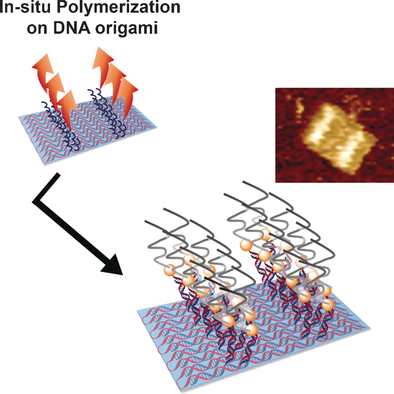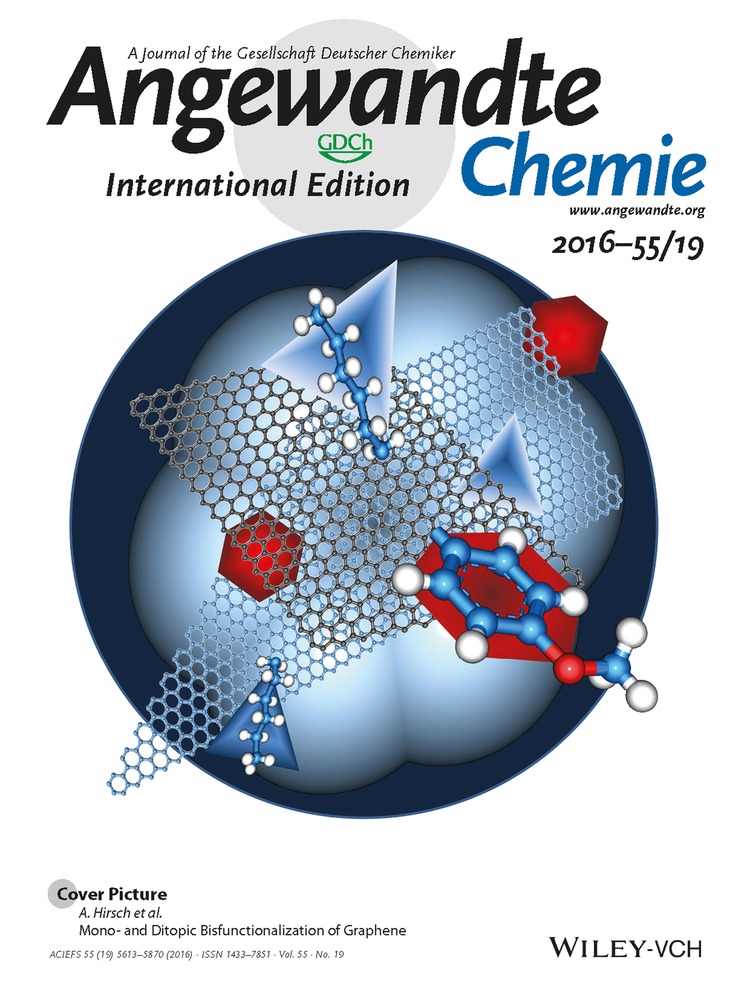Bottom-Up Fabrication of Nanopatterned Polymers on DNA Origami by In Situ Atom-Transfer Radical Polymerization
Yu Tokura
Organic Chemistry III, Macromolecular Chemistry and Biomaterials, Ulm University, Albert-Einstein-Allee 11, 89081 Ulm, Germany
These authors contributed equally to this work.
Search for more papers by this authorYanyan Jiang
Organic Chemistry III, Macromolecular Chemistry and Biomaterials, Ulm University, Albert-Einstein-Allee 11, 89081 Ulm, Germany
Centre for Advanced Macromolecular Design (CAMD), School of Chemistry, University of New South Wales, Sydney, NSW, 2052 Australia
These authors contributed equally to this work.
Search for more papers by this authorDr. Alexander Welle
Preparative Macromolecular Chemistry, Institute for Technical Chemistry and Polymer Chemistry, Karlsruhe Institute of Technology (KIT), Engesserstrasse 18, 76131 Karlsruhe, Germany
Institute for Biological Interfaces, Karlsruhe Institute of Technology (KIT), Hermann-von-Helmholtz-Platz 1, 76344 Eggenstein-Leopoldshafen, Germany
Karlsruhe Nano Micro Facility, Karlsruhe Institute of Technology (KIT), Hermann-von-Helmholtz-Platz 1, 76344 Eggenstein-Leopoldshafen, Germany
Search for more papers by this authorProf. Martina H. Stenzel
Centre for Advanced Macromolecular Design (CAMD), School of Chemistry, University of New South Wales, Sydney, NSW, 2052 Australia
Search for more papers by this authorKatarzyna M. Krzemien
Institute of Biophysics, Ulm University, Albert-Einstein-Allee 11, 89081 Ulm, Germany
Search for more papers by this authorProf. Jens Michaelis
Institute of Biophysics, Ulm University, Albert-Einstein-Allee 11, 89081 Ulm, Germany
Search for more papers by this authorDr. Rüdiger Berger
Max Planck Institute for Polymer Research, Ackermannweg 10, 55128 Mainz, Germany
Search for more papers by this authorProf. Christopher Barner-Kowollik
Preparative Macromolecular Chemistry, Institute for Technical Chemistry and Polymer Chemistry, Karlsruhe Institute of Technology (KIT), Engesserstrasse 18, 76131 Karlsruhe, Germany
Institute for Biological Interfaces, Karlsruhe Institute of Technology (KIT), Hermann-von-Helmholtz-Platz 1, 76344 Eggenstein-Leopoldshafen, Germany
Search for more papers by this authorCorresponding Author
Dr. Yuzhou Wu
Organic Chemistry III, Macromolecular Chemistry and Biomaterials, Ulm University, Albert-Einstein-Allee 11, 89081 Ulm, Germany
Search for more papers by this authorCorresponding Author
Prof. Tanja Weil
Organic Chemistry III, Macromolecular Chemistry and Biomaterials, Ulm University, Albert-Einstein-Allee 11, 89081 Ulm, Germany
Search for more papers by this authorYu Tokura
Organic Chemistry III, Macromolecular Chemistry and Biomaterials, Ulm University, Albert-Einstein-Allee 11, 89081 Ulm, Germany
These authors contributed equally to this work.
Search for more papers by this authorYanyan Jiang
Organic Chemistry III, Macromolecular Chemistry and Biomaterials, Ulm University, Albert-Einstein-Allee 11, 89081 Ulm, Germany
Centre for Advanced Macromolecular Design (CAMD), School of Chemistry, University of New South Wales, Sydney, NSW, 2052 Australia
These authors contributed equally to this work.
Search for more papers by this authorDr. Alexander Welle
Preparative Macromolecular Chemistry, Institute for Technical Chemistry and Polymer Chemistry, Karlsruhe Institute of Technology (KIT), Engesserstrasse 18, 76131 Karlsruhe, Germany
Institute for Biological Interfaces, Karlsruhe Institute of Technology (KIT), Hermann-von-Helmholtz-Platz 1, 76344 Eggenstein-Leopoldshafen, Germany
Karlsruhe Nano Micro Facility, Karlsruhe Institute of Technology (KIT), Hermann-von-Helmholtz-Platz 1, 76344 Eggenstein-Leopoldshafen, Germany
Search for more papers by this authorProf. Martina H. Stenzel
Centre for Advanced Macromolecular Design (CAMD), School of Chemistry, University of New South Wales, Sydney, NSW, 2052 Australia
Search for more papers by this authorKatarzyna M. Krzemien
Institute of Biophysics, Ulm University, Albert-Einstein-Allee 11, 89081 Ulm, Germany
Search for more papers by this authorProf. Jens Michaelis
Institute of Biophysics, Ulm University, Albert-Einstein-Allee 11, 89081 Ulm, Germany
Search for more papers by this authorDr. Rüdiger Berger
Max Planck Institute for Polymer Research, Ackermannweg 10, 55128 Mainz, Germany
Search for more papers by this authorProf. Christopher Barner-Kowollik
Preparative Macromolecular Chemistry, Institute for Technical Chemistry and Polymer Chemistry, Karlsruhe Institute of Technology (KIT), Engesserstrasse 18, 76131 Karlsruhe, Germany
Institute for Biological Interfaces, Karlsruhe Institute of Technology (KIT), Hermann-von-Helmholtz-Platz 1, 76344 Eggenstein-Leopoldshafen, Germany
Search for more papers by this authorCorresponding Author
Dr. Yuzhou Wu
Organic Chemistry III, Macromolecular Chemistry and Biomaterials, Ulm University, Albert-Einstein-Allee 11, 89081 Ulm, Germany
Search for more papers by this authorCorresponding Author
Prof. Tanja Weil
Organic Chemistry III, Macromolecular Chemistry and Biomaterials, Ulm University, Albert-Einstein-Allee 11, 89081 Ulm, Germany
Search for more papers by this authorGraphical Abstract
Surface-initiated polymerization reactions on DNA origami enable the precise design of nanopatterned polymers. Characterization by atomic force microscopy, gel electrophoresis, and time-of-flight secondary-ion mass spectrometry showed that this approach can be used to fabricate polymers of different patterns and lengths on the nanoscale.
Abstract
Bottom-up strategies to fabricate patterned polymers at the nanoscale represent an emerging field in the development of advanced nanodevices, such as biosensors, nanofluidics, and nanophotonics. DNA origami techniques provide access to distinct architectures of various sizes and shapes and present manifold opportunities for functionalization at the nanoscale with the highest precision. Herein, we conduct in situ atom-transfer radical polymerization (ATRP) on DNA origami, yielding differently nanopatterned polymers of various heights. After cross-linking, the grafted polymeric nanostructures can even stably exist in solution without the DNA origami template. This straightforward approach allows for the fabrication of patterned polymers with low nanometer resolution, which provides access to unique DNA-based functional hybrid materials.
Supporting Information
As a service to our authors and readers, this journal provides supporting information supplied by the authors. Such materials are peer reviewed and may be re-organized for online delivery, but are not copy-edited or typeset. Technical support issues arising from supporting information (other than missing files) should be addressed to the authors.
| Filename | Description |
|---|---|
| anie201511761-sup-0001-misc_information.pdf891.6 KB | Supplementary |
Please note: The publisher is not responsible for the content or functionality of any supporting information supplied by the authors. Any queries (other than missing content) should be directed to the corresponding author for the article.
References
- 1
- 1aM. Geissler, Y. N. Xia, Adv. Mater. 2004, 16, 1249–1269;
- 1bP. T. Hammond, Adv. Mater. 2004, 16, 1271–1293;
- 1cP. Kim, S. E. Lee, H. S. Jung, H. Y. Lee, T. Kawai, K. Y. Suh, Lab Chip 2006, 6, 54–59.
- 2M. El Garah, N. Marets, M. Mauro, A. Aliprandi, S. Bonacchi, L. De Cola, A. Ciesielski, V. Bulach, M. W. Hosseini, P. Samorì, J. Am. Chem. Soc. 2015, 137, 8450–8459.
- 3J. Lucon, S. Qazi, M. Uchida, G. J. Bedwell, B. LaFrance, P. E. Prevelige, T. Douglas, Nat. Chem. 2012, 4, 781–788.
- 4
- 4aP. W. Rothemund, Nature 2006, 440, 297–302;
- 4bC. E. Castro, F. Kilchherr, D. N. Kim, E. L. Shiao, T. Wauer, P. Wortmann, M. Bathe, H. Dietz, Nat. Methods 2011, 8, 221–229;
- 4cV. Linko, H. Dietz, Curr. Opin. Biotechnol. 2013, 24, 555–561.
- 5
- 5aB. Saccà, R. Meyer, M. Erkelenz, K. Kiko, A. Arndt, H. Schroeder, K. S. Rabe, C. M. Niemeyer, Angew. Chem. Int. Ed. 2010, 49, 9378–9383; Angew. Chem. 2010, 122, 9568–9573;
- 5bJ. L. Fu, Y. R. Yang, A. Johnson-Buck, M. H. Liu, Y. Liu, N. G. Walter, N. W. Woodbury, H. Yan, Nat. Nanotechnol. 2014, 9, 531–536.
- 6
- 6aR. Schreiber, J. Do, E. M. Roller, T. Zhang, V. J. Schüller, P. C. Nickels, J. Feldmann, T. Liedl, Nat. Nanotechnol. 2014, 9, 74–78;
- 6bT. Zhang, A. Neumann, J. Lindlau, Y. Wu, G. Pramanik, B. Naydenov, F. Jelezko, F. Schüder, S. Huber, M. Huber, F. Stehr, A. Högele, T. Weil, T. Liedl, J. Am. Chem. Soc. 2015, 137, 9776–9779.
- 7
- 7aP. K. Dutta, R. Varghese, J. Nangreave, S. Lin, H. Yan, Y. Liu, J. Am. Chem. Soc. 2011, 133, 11985–11993;
- 7bC. X. Lin, R. Jungmann, A. M. Leifer, C. Li, D. Levner, G. M. Church, W. M. Shih, P. Yin, Nat. Chem. 2012, 4, 832–839.
- 8
- 8aJ. B. Knudsen, L. Liu, A. L. B. Kodal, M. Madsen, Q. Li, J. Song, J. B. Woehrstein, S. F. J. Wickham, M. T. Strauss, F. Schueder, J. Vinther, A. Krissanaprasit, D. Gudnason, A. A. A. Smith, R. Ogaki, A. N. Zelikin, F. Besenbacher, V. Birkedal, P. Yin, W. M. Shih, R. Jungmann, M. D. Dong, K. V. Gothelf, Nat. Nanotechnol. 2015, 10, 892–898;
- 8bA. Krissanaprasit, M. Madsen, J. B. Knudsen, D. Gudnason, W. Surareungchai, V. Birkedal, K. V. Gothelf, ACS. Nano 2016, 10, 2243–2250.
- 9
- 9aN. V. Voigt, T. Torring, A. Rotaru, M. F. Jacobsen, J. B. Ravnsbaek, R. Subramani, W. Mamdouh, J. Kjems, A. Mokhir, F. Besenbacher, K. V. Gothelf, Nat. Nanotechnol. 2010, 5, 200–203;
- 9bM. Endo, Y. Yang, H. Sugiyama, Biomater. Sci. 2013, 1, 347–360;
- 9cA. H. Okholm, H. Aslan, F. Besenbacher, M. Dong, J. Kjems, Nanoscale 2015, 7, 10970–10973.
- 10
- 10aK. L. Heredia, D. Bontempo, T. Ly, J. T. Byers, S. Halstenberg, H. D. Maynard, J. Am. Chem. Soc. 2005, 127, 16955–16960;
- 10bJ. Liu, V. Bulmus, D. L. Herlambang, C. Barner-Kowollik, M. H. Stenzel, T. P. Davis, Angew. Chem. Int. Ed. 2007, 46, 3099–3103; Angew. Chem. 2007, 119, 3159–3163;
- 10cP. De, M. Li, S. R. Gondi, B. S. Sumerlin, J. Am. Chem. Soc. 2008, 130, 11288;
- 10dY. Z. Qi, A. Chilkoti, Polym. Chem. 2014, 5, 266–276.
- 11
- 11aK. Matyjaszewski, N. V. Tsarevsky, Nat. Chem. 2009, 1, 276–288;
- 11bD. J. Siegwart, J. K. Oh, K. Matyjaszewski, Prog. Polym. Sci. 2012, 37, 18–37.
- 12S. M. Ryan, G. Mantovani, X. X. Wang, D. M. Haddleton, D. J. Brayden, Expert Opin. Drug Delivery 2008, 5, 371–383.
- 13D. Bontempo, H. D. Maynard, J. Am. Chem. Soc. 2005, 127, 6508–6509.
- 14E. Stahl, T. G. Martin, F. Praetorius, H. Dietz, Angew. Chem. Int. Ed. 2014, 53, 12735–12740; Angew. Chem. 2014, 126, 12949–12954.
- 15N. Backmann, N. Kappeler, T. Braun, F. Huber, H.-P. Lang, C. Gerber, R. Y. H. Lim, Beilstein J. Nanotechnol. 2010, 1, 3–13.
- 16L. Peng, C. Wu, M. You, D. Han, Y. Chen, T. Fu, M. Ye, W. Tan, Chem. Sci. 2013, 4, 1928–1938.
- 17Y. Z. Wu, D. Y. W. Ng, S. L. Kuan, T. Weil, Biomater. Sci. 2015, 3, 214–230.
Citing Literature
May 4, 2016
Pages 5692-5697





